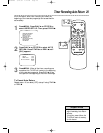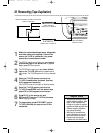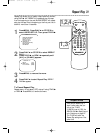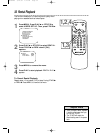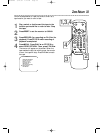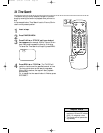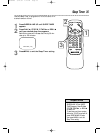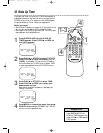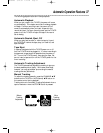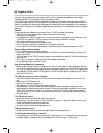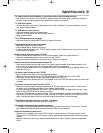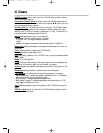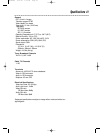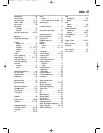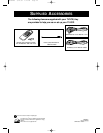
AUDIO In Jack: jack on the front of the TV/VCR which is used to record
audio from another source.
Automatic Channel Setup:
process in which the TV/VCR memorizes all
available channels. Then, when you push the CH(annel) ▲/▼ button, you only
scan through channels you receive.
Auxiliary (AUX):
The channel to which you set your TV/VCR during dub-
bing or when viewing material that is playing on another device that is con-
nected to the TV/VCR (for example, a camcorder or VCR). The auxiliary (or
line input) channel is always channel 00 (AUX).
Bands:
settings that allow you to tune channels.
• Antenna – VHF (very high frequency; channels
2-13) and UHF (ultra high frequency; channels
14-69).
• Cable – all standard channels can be received without a Cable Box.
Brightness:
adjusting increases or decreases the brightness of the color on
the screen.
Color
: adjusting pales or brightens the TV/VCR color.
Dubbing:
copying a tape using a VCR.
HQ:
high quality; a feature in the TV/VCR circuitry which provides enhanced
picture detail.
Mode:
a TV/VCR operation.
OTR:
One-Touch Recording; a timed recording that starts immediately and
records for 30 minutes to eight hours, whichever you specify.
Picture:
adjusting increases or decreases the contrast of the picture on the
screen.
Sharpness:
adjusting softens or clarifies the picture on the screen.
Tape Speeds:
how fast the tape travels during playback or recording.
• SP (standard play) – fastest tape speed (recording time for a T120 tape is
approximately two hours); best picture quality.
• LP (long play) – average tape speed; playback only.
• SLP (super long play) – slowest tape speed (recording time for a T120
tape is approximately six hours).
Tint
: adjusting changes the tints of the picture on the TV/VCR from purple to
green.
VIDEO In Jack:
jack on the front of the TV/VCR which is used to record
video from another source.
40 Glossary
MC09D1MG 3/22/02 1:16 PM Page 40



